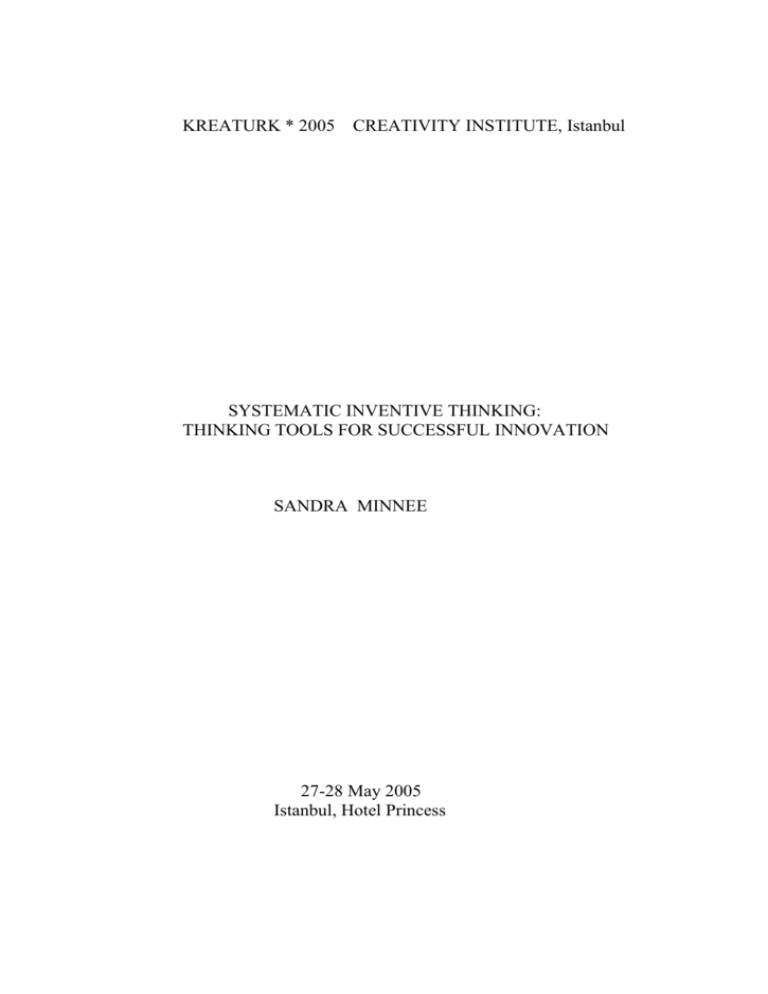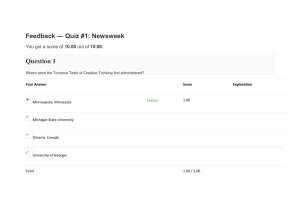Systematic Inventive Thinking (SIT): thinking tools
advertisement

KREATURK * 2005 CREATIVITY INSTITUTE, Istanbul SYSTEMATIC INVENTIVE THINKING: THINKING TOOLS FOR SUCCESSFUL INNOVATION SANDRA MINNEE 27-28 May 2005 Istanbul, Hotel Princess Creativity and Innovation Many companies use several creativity techniques to assist them in innovation and new product development. Brainstorming is the most well known. In these kind of sessions, one uses several techiques, such as the Six Thinking Hats form Edward de Bono. The effectivity of such sessions is not always clear to everyone. Usually lots of ideas are generated, but the applicability of many of them is questionable. Because many creativtiy techniques work according to the principle of free association, the ideas usually get to go quite far from the work field of the company. Brainstormsessions are fun to do and have a very strong effect on team building. But one has to make sure they are usuful and that ideas are tested for the quality of being a true solution to the problem at heart. Finally, the solutions should be put into a concrete action plan, so as to ensure effectivity. Systematic Inventive Thinking (SIT) Jacob Goldenberg at the University of Tel Aviv in Israel debates that creativity flourishes better under constraints than in total freedom (Goldenberg & Mazursky, 2002). In the 1920’s the russion scientist Genrich Altshuller examined thousands of successful innovations in order to find out that there were about fifty universal (thinking) principles that had led to them. He brought them together in the creativity technique TRIZ. Goldenberg refined this approach further and developed a creativity techniqe which uses a systematic approach and about 5 highly effective thinking tools: systematic inventive thinking (SIT). In SIT there are several important principles: 1. Stay in the closed world of the product or service. Innovations should be sought within the manipulation of the components of the product (internal world) and its close surroundings (external world). 2. Systematically apply several thinking tools in order to find ‘virtual products or services’. Goldenberg identified 5 so called ‘creativity templates’: a. Reduction b. Replacement c. Division d. Multiplication e. Attribute relationships 3. By applying the thinking tools, virtual new products are being found. These virtual products go through 2 filters: a. Market filter: is there a need for this virual product, who would be the target group; if the answer is yes, then the second filter is applied: b. Technology filter: is the virtual product technologically feasible? If the answer is yes again, some necessary adaptations and changes are made and only then the virtual product is called an idea. 4. The best ideas are being put into action and regular market research is being applied in order to establish the viability, price, market volume, etc. 5. The most viable ideas are implemented. This principle of development is called Function Follows Form. Contrary to most new product development procedures, the starting point for finding new ideas is not the consumer, his needs or wishes, but an existing product or service. Existing products have a lot of creativity in them already and they have proven their existence in the market place. Also, consumers are often not aware of needs for non existing products. When they are aware of their needs, your competitor can also find out! Qualitative Change Within Systematic Inventive Thinking, an innovation is thought to be successful if 1. it is found within the closed world of the product or service, i.e. no totally new components have been added to come to the new product 2. the change from the existing product is substantial, not incremental. Smaller sizes would not be considerd a true innovation in SIT terms, even though it can be a highly succesful innovation! Systematic Inventive Thinking is independent of domains and can also be applied to problem solving. It is a method which is easy to do, because we do it naturally. Research and development people usually like the systematic and down to earth approach and are easily committed to participate in a creativity session with SIT! References: Creativity in Product Innovation, J. Goldenberg & D, Mazursky, 2002 SIT International, Israel: www.sitsite.com










